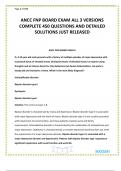Page 1 of 157
ANCC FNP BOARD EXAM ALL 3 VERSIONS
COMPLETE 450 QUESTIONS AND DETAILED
SOLUTIONS JUST RELEASED
ANCC FNP BOARD EXAM A
Q. A 24-year-old male presents with a history of multiple episodes of major depression with
occasional bouts of elevated mood. During the bouts of elevated mood, he reports racing
thoughts and an intense desire for risky behaviors but denies hallucinations. He works a
steady job and maintains a home. Which is the most likely diagnosis?
Schizoaffective disorder
Bipolar disorder type II
Dysthymia
Bipolar disorder type I
Solution: The correct answer is B.
Bipolar disorder is characterized by mania and depression. Bipolar disorder type II is associated
with major depression and low levels of mania. Bipolar disorder type II is not usually associated
with impairment of social function, and many patients maintain work and family
requirements. Schizoafective disorder is characterized by the combination of schizophrenia and
major depression. Dysthymia is characterized by a constant depressed mood but does not meet
the requirement of a major depressive disorder. Bipolar disorder type I is associated with a
major depressive disorder and hypermania. Patients with bipolar disorder type I experience
significant impairment with social function and work life.
1
SUCCESS!
,Page 2 of 157
Which immunizations should an adolescent aged 12 receive as a component of preventative
care? Select all that apply.
Human papillomavirus (HPV) vaccine
Initial measles, mumps, and rubella (MMR) vaccine
Tetanus and diphtheria toxoids (TDaP) booster
Hepatitis B vaccine
Meningococcal conjugate vaccine
Solution: The correct answers are A, C and E.
Between ages 11 and 12, the adolescent should receive tetanus and diphtheria toxoids booster,
the human papillomavirus (HPV) vaccine, and the meningococcal conjugate vaccine. Certain
populations, such as adolescents with heart disease, sickle-cell disease, and human
immunodeficiency virus (HIV), may also require the pneumococcal vaccine, the hepatitis A
series, and the influenza vaccine, but these are not considered routine at age 12.
Rifampin, ethambutol, and pyrazinamide
The Centers for Disease Control and Prevention (CDC) recommends the use of rifampin,
ethambutol, pyrazinamide, isoniazid, and rifapentine for use in treatment
Which instructions should be provided to a patient with newly diagnosed ulcerative colitis
(UC)? Select all that apply.
Annual colorectal screenings are important to decrease cancer risks.
Control of ulcerative colitis requires medication and diet counseling.
Due to high risk of appendicitis, report any right lower quadrant pain immediately.
Due to an increased risk of colorectal cancer, you need to report any changes in the UC
immediately.
Limit the number of sexual partners.
Solution: The correct answers are A, B and D.
2
SUCCESS!
,Page 3 of 157
Patients with family history and/or with chronic ulcerative colitis (UC) or Crohn’s disease have
an increased risk of developing colorectal cancer. Patients with ulcerative colitis do not have an
increased risk of developing appendicitis. Patients with ulcerative colitis can manage well if the
condition is controlled with medication and diet. The number of sexual partners does not
increase the risk for complications of UC.
Beck Depression Inventory
The Beck Depression Inventory should provide data to assist the diagnosis and treatment.
postpartum depression
Mini-Mental State Examination (MMSE)
A test that is used to measure cognitive ability, especially in late adulthood.
A 70-year-old male presents for a routine physical. Upon obtaining a complete history, the
nurse practitioner notes a 40-year smoking history, chicken pox as a child, no known allergies,
and type-2 diabetes. The patient has not had a physical performed in several years. What
vaccines should the nurse practitioner include in the plan of treatment? Select all that apply.
Influenza vaccine
Pneumococcal vaccine
Zoster vaccine live
Meningococcal conjugate vaccine
Varicella vaccine
All adults older than 65 years of age should receive a pneumococcal vaccine. A shingles vaccine
should be given to adults at age 60 and over who have a history of a previous chicken pox
diagnosis. An influenza vaccination is recommended for adults as a seasonal precaution. A
meningococcal conjugate vaccine is administered to younger individuals such as preteens,
teens, and college-aged adults. A varicella vaccine is given in children to prevent chicken pox.
A 46-year-old African American male, without a family history of prostate cancer, presents to
the clinic for an annual physical exam. Which screening would be recommended for this
3
SUCCESS!
, Page 4 of 157
patient? Select all that apply.
Prostate-specific antigen (PSA) test
Computerized tomography (CT) scan
Digital rectal examination (DRE
Colonoscopy
Ultrasound
Solution: The correct answers are A and C.
The American Cancer Society recommends that men at high risk for prostate cancer begin
testing (prostate-specific antigen [PSA] and digital rectal examination [DRE]) at age 45, including
African Americans and men with a first-degree relative (father, brother, son) diagnosed with
prostate cancer before age 65. Testing should begin at age 40 for those at higher risk (more
than one first-degree relative diagnosed with prostate cancer at an early age). Otherwise,
testing should be offered yearly beginning at age 50. The incidence of prostate cancer increases
after age 50. The digital rectal examination, which identifies enlargement or irregularity of the
prostate, and the PSA test, a tumor marker for prostate cancer, are effective diagnostic
measures. A colonoscopy does not screen for cancer of the prostate. An ultrasound and
computerized tomography (CT) scan would be ordered to determine how far cancer has spread,
not as a screening tool.
The nurse practitioner is performing skin screening for a group of adult patients during a free
skin-cancer screening clinic. Which patient would be considered at the greatest risk?
An elderly African American male from the state of Maine
An elderly Hispanic female who moved from Central America at age 1
An elderly female who has a family history of basal cell carcinoma
An elderly male who was a redhead with fair skin during his life
olution: The correct answer is D.
Fair-skinned individuals have very little melanin in the skin and have an increased risk of
ultraviolet (UV) damage to the underlying membranes. This lifetime of UV damage creates
4
SUCCESS!





